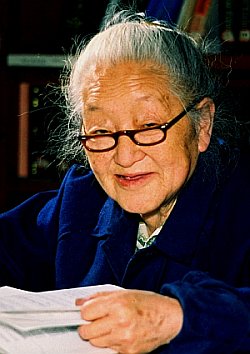 ZEHUI, He (1914 - 2011)
ZEHUI, He (1914 - 2011)

He Zehui was a nuclear physicist, member of the Chinese Academy of Sciences, one of the pioneers in nuclear science and technology and a key figure in the development of scientific ballooning in China.
She was born on 5th of March, 1914 in Suzhou, Jiangsu Province. She graduated from the Physics Department of Tsinghua University in 1936, and received a Doctor degree from the Technische Hochschule in Berlin in 1940. After working 3 years in Siemens Werner Werk, in 1943, she joined the Institute of Nuclear Physics of K.W.I. in Heidelberg, working under the supervision of Prof. W.Bothe. There, while studying the positron spectrum of Mn-52, she observed for the first time the elastic scattering of electrons with positrons in a magnetic cloud chamber. In spring 1946, after his marriage with another notable Chinese phycist Qian Sanqiang, she and her husband went to Paris and worked in the Laboratoire de Chimie Nucleaire of Collége de France and Laboratoire Curie. There the couple -along with two graduate students- discovered the ternary and quaternary fissions of heavy nuclei.
After returning to China in 1948, she served successively as research professor of physics at the Institute of Atomic Physics, Institute of Modern Physics, head of the department of Neutron Physics of the Institute of Atomic Energy, and deputy director of the Institute of Atomic Energy and the Institute of High Energy Physics.
She made substantial contributions to neutron physics and physics of nuclear fission, as well as trained qualified scientists in these fields. During 1950s, she initiated in China the research and development of nuclear emulsions, which has come to the advanced world level in quality of that time, and she was awarded by Academia Sinica the first Award of the National Prize of Natural Sciences.
Around 1966, Zehui disappeared from public view as a result of the Cultural Revolution. This was over by 1978, when for the first time in more than 30 years she visited Germany as a member of a government delegation.
As head of the Cosmic Ray and Astrophysics Division of the Institute of High Energy Physics (IHEP) she promoted research in several areas. Under her initiation and fostering, the former cosmic-ray research division of IHEP built -through domestic and international collaborations- nuclear emulsion chambers which were installed in Tibet at 5500 meters of altitude, being the highest such installation on the world. As part of the advances in the field of X-ray research several detectors were under development at the time. Overcoming the mainstream of thought focused mainly on the construction of a high-energy particle accelerator, the vision and decision of He Zehui led to the creation of the first high-altitude scientific balloon launch capability to promote space astronomy and space science in China. The first launch base was established under IHEP sponsoring at the city of Xiang-He near Beijing.
Throughout her career. she published dozens of papers yet placed little value on personal fame. Very humble, she dedicated her life to science, living a simple life and always nurturing young researchers.
The "Chinese Madame Curie" as she was dubbed on several circles finally passed away in Beijing in June 20, 2011 at the age of 97.

